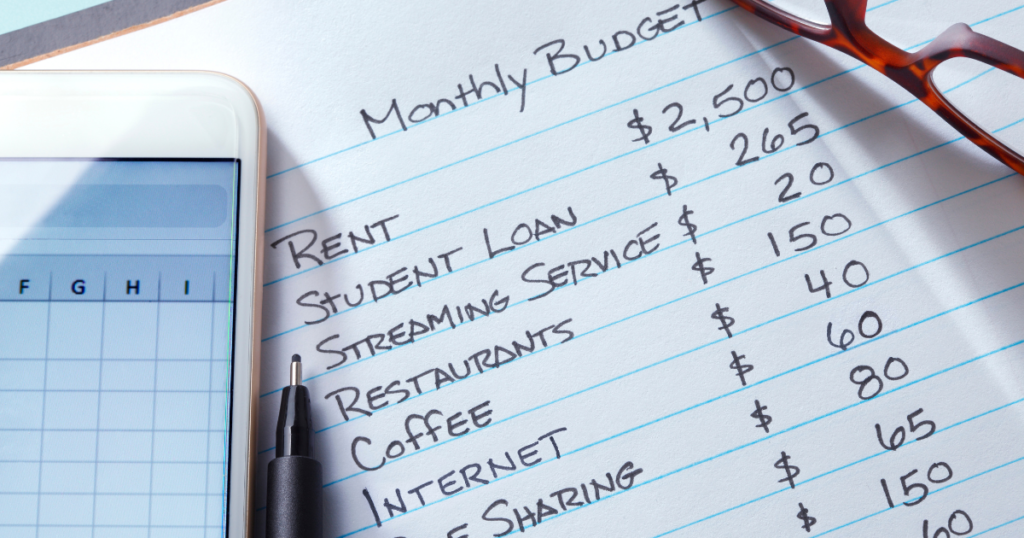How to Cut Monthly Expenses: 20 Practical Tips for Saving Money
Cutting monthly expenses is a goal for many, especially in today’s fluctuating economy. Whether you’re looking to save for a big purchase, pay off debt, or simply build an emergency fund, trimming your monthly budget is a great way to start. Here are 20 practical tips to help you learn how to cut monthly expenses.
*This post may contain affiliate links, which means that if you buy a suggested product, I will earn a small commission, at no extra cost to you. For more information, see my disclosure page.

1. Create a Budget
First and foremost, creating a detailed budget is the first step toward cutting your monthly expenses. Track your income and all your expenses for a month to see where your money is going. Use budgeting apps like YNAB (You Need A Budget) or Dave Ramsey’s Every Dollar to make this process easier. Or…if you’re old school, like me, use a pen and paper. (You can also get your FREE Budgeting Kit here, on the blog.)
A budget will help you identify areas where you can cut back and set realistic spending limits for each category.
If you need some guidance on budgeting, like where to start and what budgeting methods I prefer to use, you can read How To Do A Zero-Based Budget-Why It’s The Best Method and How To Use The Half Payment Method. The half payment method is great when you need to balance your paychecks out. It will keep you from running out of money when certain times of the month are heavier with bills. An example would be when you have large bills come out at the first of the month, like a mortgage, car payment, etc.
A zero based budget gives every dollar you make a job…meaning you have a place for it to go, not leaving any money without a purpose.

2. Cancel Unused Subscriptions
Next, go through your bank statements and identify any subscriptions you’re not using. This could include streaming services, magazine subscriptions, or gym memberships. Canceling these can save you a significant amount each month. For services you do use, consider whether you need the premium version or if a lower-tier plan will suffice.
3. Switch to a Cheaper Cell Phone Plan
Many people overpay for cell phone plans. Compare your current plan with others on the market to see if you can get the same service for less. Consider switching to a prepaid plan or a smaller carrier that uses the same network as the major providers.
For example: Switch from a major carrier to a low-cost provider like Mint Mobile, where plans can start as low as $15 a month for unlimited talk and text.
Additionally, look for plans that offer discounts for family plans or bundled services. Learning how to cut monthly expenses in this area can lead to significant savings.
4. Cut the Cable/Satellite
I mention this one in many (if not all) of my “money saving” posts because it’s a great way to free up $100-$200 a month. With so many streaming options available, cutting the cable/satellite can save you a substantial amount each month. Moreover, services like Netflix, Hulu, and Disney+ often provide more than enough entertainment for a fraction of the cost of cable. Additionally, consider free streaming services like Pluto TV (my personal favorite) or Tubi, which offer a variety of content without a subscription fee.
You may be interested in: How To Ditch Cable For Good And Save Money
5. Shop for Insurance
Insurance is a necessity, but you might be overpaying. Shop around for better rates on auto, home, and health insurance. You can often save by bundling policies with one provider. Furthermore, don’t hesitate to ask your current insurance company for a better rate or to match a competitor’s offer.

6. Refinance Your Mortgage
If you own a home, consider refinancing your mortgage to take advantage of lower interest rates, if they’re available. This can lower your monthly payment and save you thousands over the life of the loan. Additionally, be sure to factor in the costs associated with refinancing to ensure it’s worth the investment.
7. Cook at Home
One of the easiest ways to cut your monthly expenses is to cook at home. Eating out can quickly drain your budget, especially with today’s prices. Plan your meals, make a grocery list, and cook at home as much as possible. Not only is it cheaper, but it’s often healthier too. Additionally, consider meal prepping to save time and reduce the temptation to order takeout.
For example: Replace weekly takeout meals with a planned meal-prep session on Sundays. Preparing several dinners at once can save both time and money throughout the week.
You may be interested in: Reverse Meal Planning: Easy Solutions To Save Time And Money

8. Buy Generic Brands
When shopping, opt for generic brands (store brands) instead of name brands. Many generic products are just as good as their branded counterparts but cost 30%-50% less for the same ingredients. This applies to groceries, medications, and household products and can significantly cut your monthly grocery expenses.
9. Use Coupons and Cash Back Apps
Take advantage of coupons and cash back apps like Fetch (my favorite), Rakuten or Ibotta when you shop. These tools can help you save money on groceries, clothing, and other essentials. Additionally, sign up for store loyalty programs to get exclusive discounts and offers.
10. Reduce Utility Bills
Simple changes can reduce your utility bills. Turn off lights when not in use, unplug electronics, and use energy-efficient appliances. Consider installing a programmable thermostat to better manage your heating and cooling costs. Check for leaks or drafts in your home that could be causing higher energy usage. Also, try and use your dryer as little as possible by line drying your clothes. This can save a significant amount of energy. Learning how to cut monthly expenses on utilities can lead to noticeable savings.
You might consider: Honeywell Programmable Thermostat
11. Drive Less
Cutting back on driving can save on fuel and maintenance costs. Carpool, use public transportation, bike, or walk whenever possible. If you have a two-car household, consider whether you can get by with one car. Additionally, keep your car well-maintained to improve fuel efficiency and avoid costly repairs.
12. Review Your Credit Card Statements
Regularly review your credit card statements for any unauthorized charges or subscriptions you forgot about. Paying off your balance each month can also save you money on interest. If you carry a balance, consider transferring it to a card with a lower interest rate or a 0% introductory APR offer.
Also, if you have a credit card with ‘rewards’, keep track of how many you have, each month. I recently noticed that my ‘rewards’ points amount went from 11,000 down to 2,000. Somehow, someone had stolen most of my points. It took about a month, but I was able to get them back. The bank had no explanation as to how this happened or how they got into my ‘rewards’ account, so I had to shut down my existing card and they issued a new one. Bottom line is to be diligent.
13. DIY When Possible
Instead of hiring someone for repairs or home improvements, try doing it yourself. There are countless tutorials online (YouTube) that can guide you through simple repairs and projects. Not only can this save you money, but it can also be a rewarding experience. We have saved hundreds (if not thousands) by DIYing ourselves. There’s literally a video for everything!
For example: Learn to replace a leaky faucet yourself by watching a tutorial online. The cost of parts might be $30 compared to the $150 (or more) that you’d pay a plumber.
14. Limit Online Shopping
Impulse buying online can quickly add up. Try to limit your online shopping and make sure any purchase is planned and budgeted. Also, unsubscribe from promotional emails and remove saved payment information to make it harder to make spontaneous purchases.
If you have shopping apps (Amazon comes to mind) on your phone, remove them and remove the temptation! You also should unsubscribe from retail email lists to avoid impulse buys when browsing online stores.
15. Negotiate Bills
You might be able to negotiate lower rates on bills like your internet, cable, and even medical bills. It never hurts to ask for a better deal and many companies are willing to work with you to keep you as a customer. A few minutes of time on the phone could possibly save you hundreds.
16. Avoid Convenience Stores
Convenience stores often have higher prices than grocery stores. Plan ahead and buy your snacks and drinks at the grocery store to save money. This also applies to items like over-the-counter medications and household supplies.
For example: Purchase a bulk pack of snacks at a warehouse store like Costco, Sam’s or even Walmart for $10 instead of buying individual items from a convenience store for $2-3 each.
17. Use a Shopping List
Stick to a shopping list when you go to the store to avoid impulse buys. This will help you stay on budget and only buy what you need. Take inventory of what you already have at home to avoid purchasing duplicates.
If you haven’t tried online grocery shopping, you should give it a try. Shopping this way reduces the temptations you may have by going in the store and you can see what your running balance is while your shopping online. This makes it so much easier to stay within budget AND saves you time, as well.
18. Set Savings Goals
This one is so important, my friend. Keep your eye on the prize!
Having specific savings goals can motivate you to cut expenses. Whether it’s saving for a vacation, a new car, or an emergency fund, knowing what you’re working towards can help keep you on track. Break down larger goals into smaller, more manageable milestones to stay motivated.
For example: Set a goal to save $500 in three months for a vacation. Break it down to saving $167 per month by cutting non-essential expenses like entertainment and dining out.
19. Limit Entertainment Expenses
You don’t have to spend a lot of money to have a great time!
Look for free or low-cost entertainment options in your area. Many communities offer free events, parks, and libraries that provide great entertainment without the high costs. Take advantage of free trials for streaming services and cancel before the trial period ends if you decide not to keep the service.
20. Track Your Progress
Regularly review your budget and track your progress. This will help you see how much you’re saving and where you might need to make further adjustments. Moreover, celebrate your successes and make changes as needed to stay on track with your financial goals.
Final Thoughts…
Cutting monthly expenses doesn’t have to mean sacrificing your quality of life. By making mindful choices and implementing these practical tips on how to cut monthly expenses, you can free up money for the things that matter most to you.
Start small by targeting easy areas first, and then gradually incorporate more strategies as you get comfortable. Remember, consistency is key. The more you practice these habits, the more natural they will become, leading to significant savings over time. Additionally, regularly reviewing and adjusting your budget will ensure you stay on track and make the most of your financial efforts. So, take control of your finances today and watch your savings grow!
For more money-saving tips and strategies, subscribe to our newsletter at Love to Frugal! You can also follow me on Pinterest, Facebook & Instagram for even more money saving, frugal living tips!
OTHER POSTS YOU MAY BE INTERESTED IN:
Old Fashioned Frugal Homemaking Tips
How To Improve Your Finances With A No Spend Month Challenge
How To Live A Fabulous Lifestyle On A Frugal Budget


